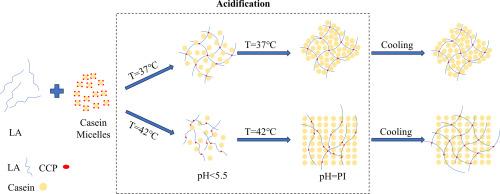脱脂奶/低酰基结冷胶双凝胶的形成和物理性质:凝胶化顺序的影响
IF 10.7
1区 化学
Q1 CHEMISTRY, APPLIED
引用次数: 0
摘要
低酰基结冷胶(LA)是一种典型的冷凝胶和钙凝胶多糖,被广泛用于提高酸奶的稳定性。酸和内源性钙可诱导脱脂奶(SM)/LA 双凝胶的形成。然而,酸化温度对 SM/LA 双凝胶的形成和物理性质的影响尚未阐明。本研究采用高于和低于LA转变温度(38 °C)的温度作为酸化温度,以调整SM和LA的凝胶化顺序。先于SM凝胶的LA凝胶在酸化温度为37 °C时形成,在所有样品中表现出最高的WHC和G′。此外,SM/LA-37 双凝胶显示出两种网络:一种是多孔网络,另一种是致密网络。相比之下,在 42 °C 下酸化的 SM/LA 混合物在冷却阶段形成了双层网络,之前形成的 SM 凝胶阻碍了 LA 凝胶的形成。因此,与 SM/LA-37 双凝胶相比,SM/LA-42 双凝胶显示出较低的 WHC 和 G′。总之,凝胶化顺序对 SM/LA 双凝胶的物理性质有很大影响。我们的研究结果为采用最佳方法提高酸奶质量和揭示 SM/LA 双凝胶的凝胶化机制提供了依据。本文章由计算机程序翻译,如有差异,请以英文原文为准。

Formation and physical properties of skimmed milk/low-acyl gellan gum double gels: Influence of gelation sequence
Low-acyl gellan gum (LA) is a typical cold- and Ca2+-set gelation polysaccharide and is widely used to improve the stability of yoghurt. Acid and endogenous calcium can induce the formation of skimmed milk (SM)/LA double gels. However, the effect of acidification temperature on the formation and physical properties of SM/LA double gels has not been elucidated. In this study, temperature above and below the LA transition temperature (38 °C) were used as acidification temperatures, which adjusted the gelation sequence of SM and LA. The LA gel prior to the SM gel formed at acidification temperature of 37 °C, exhibiting the highest WHC and G′ among all samples. Moreover, SM/LA-37 double gels showed two networks: one was a porous network and the other was a dense network. By contrast, SM/LA mixtures acidified at 42 °C formed double networks during the cooling stage, and the previously formed SM gel hindered the formation of the LA gel. Consequently, SM/LA-42 double gels showed lower WHC and G′ compared with SM/LA-37 double gels. Overall, gelation sequence substantially affected the physical properties of SM/LA double gels. Our findings provide basis for adopting optimal methods to improve yoghurt quality and revealing the gelation mechanism involved in SM/LA double gels.
求助全文
通过发布文献求助,成功后即可免费获取论文全文。
去求助
来源期刊

Carbohydrate Polymers
化学-高分子科学
CiteScore
22.40
自引率
8.00%
发文量
1286
审稿时长
47 days
期刊介绍:
Carbohydrate Polymers stands as a prominent journal in the glycoscience field, dedicated to exploring and harnessing the potential of polysaccharides with applications spanning bioenergy, bioplastics, biomaterials, biorefining, chemistry, drug delivery, food, health, nanotechnology, packaging, paper, pharmaceuticals, medicine, oil recovery, textiles, tissue engineering, wood, and various aspects of glycoscience.
The journal emphasizes the central role of well-characterized carbohydrate polymers, highlighting their significance as the primary focus rather than a peripheral topic. Each paper must prominently feature at least one named carbohydrate polymer, evident in both citation and title, with a commitment to innovative research that advances scientific knowledge.
 求助内容:
求助内容: 应助结果提醒方式:
应助结果提醒方式:


